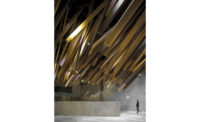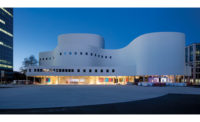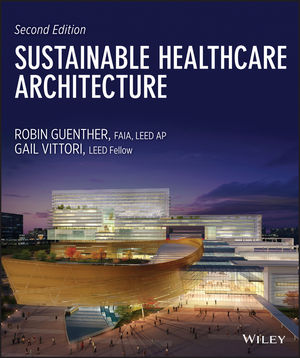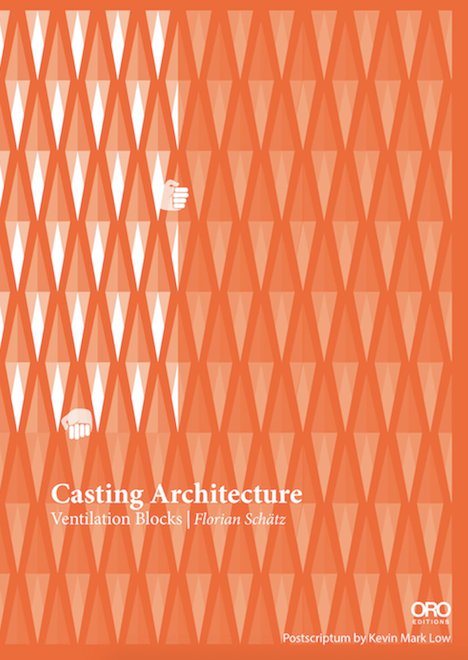The public space in the middle of Singapore’s recently completed Marina One complex provides genuine respite. Above the district of concrete-and-glass towers, the noonday sun beats down relentlessly. But even though temperatures in this tropical city regularly tip to over 90 degrees Fahrenheit and humidity often hits 95 percent, it is a refreshing experience to walk through the center of this new development. Here wood and stone paths are surrounded by lush plants and trees that sway gently in an unexpected breeze.
Additional Content:
Jump to credits & specifications
Marina One, which opened at the end of last year, is built on four lots of reclaimed land totaling 6.5 acres in Marina Bay, the city-state’s expansion of its business district. The 4.3 million-square-foot complex has two 750-foot-tall 30-story office towers and two 475-foot-tall 34-story residential towers, linked on the lower levels with a podium that hosts the gardens and encloses dining and retail outlets. The assemblage sits atop underground passages with direct access to four of the city’s six metro lines.
The ambitious mixed-use center emerged out of a partnership between the state-owned investment funds of Malaysia and Singapore. In 2011, the entity named Dusseldorf, Germany– based Ingenhoven Architects the winner of an international competition. One typical approach to maximize the built volume would be to create a cube approximately 650 feet on each side and 650 feet tall. But “temperature and humidity would be working against the human condition” with such an arrangement, explains the firm’s founder, Christoph Ingenhoven. So, instead, he and his team created an ensemble clad in glass and bronze-hued metal and supported by reinforced-concrete or steel structures, carving it—and curving it—to define 398,000 square feet of gardens. This greenery is more than decorative. It contributes to the comfortable microclimate at the base of the complex, and is accessible to all, not just the center’s tenants and residents. “We have created an oasis,” says Olaf Kluge, director of the local Ingenhoven office.
One advantage of designing this kind of environment for Singapore is the year-round growing season, points out Kathryn Gustafson, founder of Gustafson Porter + Bowman (GP+B). The London-based landscape architecture firm, which is separate from Gustafson’s Seattle-based practice, developed the gardens in partnership with local ICN Design International. Still, a prime concern was selecting bushes and shrubs that would thrive even under the shade of trees and the buildings’ long shadows. But such practicalities weren’t Gustafson’s only interest. “It’s about the leaf,” she says. “Texture, size, and color are important.” Toward that end, the two firms selected 350 varieties of tropical plants.
Although the buildings’ street-facing elevations are rectilinear and almost conventional, from within the green heart, the towers are much more organic. The facades appear to undulate, an effect that is enhanced by curving metal louvers—which help shade both the gardens and the glazing—and by the floor plates of the office blocks. These increase in size in the upper levels of the buildings, achieved by canting the garden-facing support columns.
Within each of the office towers, the designers created nearly 1.9 million square feet of unobstructed rentable space by limiting the columns so that they are mainly on the buildings’ perimeters. In addition, they placed the elevators to the upper floors within their own silos, at the buildings’ corners. The configuration allowed for glass-enclosed capsules facing Straits View, the boulevard that hosts the complex’s main entrance. So far, space has been leased by firms that include Facebook and the banks Julius Baer and Mitsubishi UFJ Financial Group.
The residential towers have four penthouses with features like oversize terraces with their own swimming pools. However, the vast majority of the more than 1,000 condominium apartments are smaller one-to-four-bedroom units. But though these are more modest, all have balconies, many with views of the gardens or of the rapidly developing neighborhood, including its many construction sites, Moshe Safdie’s nearby Marina Bay Sands Hotel, and the soon-to-be-relocated container port.
Marina One is rational without being conventional—daring and quirky while very functional for the more than 20,000 people who will eventually live and work there. But, above all, it aims to enhance not only the well-being of its occupants, but that of anyone in the area, welcome to enjoy its serene and verdant gardens. “It is a very highdensity development,” explains Ingenhoven. “If you do density like that, you also need to be generous.”
CreditsDesign architect: ingenhoven architects, Plange Mühle 1, 40221 Düsseldorf, Germany, +49-211-30101-0 ingenhoven llp, 62B Tras Street, 079001 Singapore, +65-62210659
Personnel in architect's firm who should receive special credit: Christoph Ingenhoven, Martin Reuter, Olaf Kluge, Jae Man Bae, Arzu Bastug, Mario Böttger, Mehmet Congara, Darko Cvetuljski, Justyna Fleszar, Matthias Hemmrich, Gerald Huber, Ben Hughes, Ingo Jannek, Christian Kawe, Raphael Keane, Melik Kekec, Moritz Krogmann, Rosario Ligori, Stephan Lücke, Haitao Ma, Javier Martinez Martin, Christian Monning, Kenzo Nakakoji, Gillian Neumann, Danny Piwko, Peter Pistorius, Michael Rathgeb, Michael Reiß, Viviane Rosenbaum, Ulrike Schmälter, Markus Stöcklein, Zakiah Supahat, Jun Teraoka, Matthias Thoma, Thomas Weber, Jan Wesseling, Jhon Jairo Zamudio, Bibiana Zapf, Ivona Zelic
Associate architect (Project Architect): architects61, Singapore
Project management: UEM Sunrise Berhad, Malaysia / Mapletree Investments Pte. Ltd., Singapore
Engineering: Structural: Beca Carter Holdings & Ferner, Singapore MEP: Beca Carter Holdings & Ferner, Singapore Quantity surveyor: Langdon & Seah, Singapore
Landscape design architect: Gustafson Porter + Bowman, London
Collaborating landscape architect: ICN Design International Pte. Ltd., Singapore
Facade Engineering: Arup, Singapore
Traffic planner: MWH Global, Singapore
Fire engineer: Beca Carter Holdings & Ferner, Singapore
Interior designer (residential): Axis ID Pte Ltd, Singapore
Lighting designer: Arup, Singapore
Vertical transport engineer: Arup, Sydney
Security consultant: SKM, Singapore
Acoustic engineer: Acviron, Singapore
Main contractor: Hyundai-GS Joint Venture
Façade contractor (towers): Yuanda Curtain Wall, Shenyang, China
Façade contractor (podium): Mero Asia-Pacific Pte Ltd, Singapore
Steelwork contractor: Yongnam Engineering & Construction Pte Ltd, Singapore
Photographer: HGEsch © ingenhoven architects / HGEsch
|
SpecificationsStructural System Concrete & Steel composite structure: Hyundai-GS Joint Venture Fair-faced concrete finish: Keim Concrete
Exterior Cladding Composite flat panel soffits: Alucobond “Havanna” SS Strip ceilings: Sunray Woodcraft Construction Pte Ltd SS Embossed ceilings: Sunray Woodcraft Construction Pte Ltd Metal/glass curtain wall (towers): Yuanda Curtain Wall Metal/glass curtain wall (podium): Mero Asia-Pacific Pte Ltd Fin stairs cladding: Yuanda Curtain Wall GFRC concrete panels: Quax International Green Wall: Greenology, Singapore
Glazing Façade and canopy glass: CSG – China Specialty Glass AG, Tianjin
Doors Metal doors: Sun Tech Doors & Shutters
Hardware All hardware: FSB - Franz Schneider Brakel; GEZE GmBH
Interior Finishes SS Strip ceilings: Sunray Woodcraft Construction Pte Ltd Acoustic fabric ceilings: Kvadrat “Softcells” Acoustic timber ceiling: Topakustik Mineral tile ceiling: Armstrong “Optima” Wall coverings (auditorium): Kvadrat “Softcells” Timber fin wall cladding: The GDK Group (Singapore) Pte Ltd Solid surfacing: Corian® Carpet: Interface Inc., Singapore
Furnishings Reception furniture: Design Studio, Singapore Fixed seating (auditorium): Besco “Kotobuki” -
Lighting Interior ambient lighting: iGuzzini illuminazione S.p.A Downlights: iGuzzini illuminazione S.p.A Task lighting: IBL; Klik Systems; Erco; XAL; Feelux; LED Linear; KKDC; Zumtobel Exterior: Lumenpulse; Zumtobel; Bega; We-ef, iGuzzini; Endo; Klik Systems; LED Linear, Erco; Alto; Lumascape Dimming system (glazed lift shafts): Traxon Technologies-
Conveyance Elevators: Fujitec & Schindler Escalators: Fujitec
Energy The project has achieved approximately 20% reduction in cooling load and 33% reduction in energy consumption from the baseline code compliant requirements by making the most of passive design, energy efficient features such as heat recovery, motion sensor, regenerative lifts, and water efficient features such as provision of water sub-meters and rainwater harvesting system to minimize potable water consumption & wastage.
Greenery While the development consists of two office towers and two residential towers on a 2.63 hectares land, the design is integrated with a central ‘Green Heart’ where a multi-storey garden functions as a recreational center point for the office-goers as well as for the residents. Plants dotted around the development will form a unique scenery in the heart of the city, besides serving as natural cooler due to their evapotranspiration effect. Furthermore, the regimented forest in the development promotes biodiversity around the city state, in coherence with the master plan of Singapore to build a “City in the Garden”.
Façade Design Combination of extensive shading elements and high performance glazing reduces the solar heat gain into the building by approximately 24% as compared to a code compliant building in Singapore.
Natural Ventilation Design (residential) The thermal comfort in the residential units is further improved with good natural ventilation design, where it will achieve an average wind velocity of 0.6 m/s for most of the apartments.
Energy management or building automation system: Digital power meters and BTU meters linked to BMS to monitor and log the electrical energy consumption and amount of chilled water drawn from District Cooling Plant.
Energy Efficient Features Carbon Dioxide (CO2) sensors and heat recovery systems
Energy Efficient Features (residential) Carbon Monoxide (CO) sensors Motion sensors Highest rating (4-ticks) air conditioning under the Singapore Energy Labeling Scheme Air conditioners with heat recovery system Energy and water efficient appliances
Water Efficient Features Bib taps, sink taps, showers, urinals & basin taps rated ‘Excellent’ under the Singapore Water Efficiency Labeling Scheme (WELS); NEWater used for toilet flushing in lieu of domestic potable water
Water Efficient Features (residential) Rainwater harvesting and automatic irrigation system Water fittings with Singapore Water Efficiency Labeling Scheme (WELS) rating of “Excellent” and “Very Good” is used extensively for taps and flushing cisterns Washing machines with “Excellent” WELS rating
Environmental Protection Green cement, washed copper slag for concrete aggregate replacement and Singapore Green Label Scheme (SGLS) products; “Green” refuse chute for recyclables
Indoor Environment Quality Paints with low volatile organic compounds (VOC), UV emitters and electronic air cleaners, Pneumatic waste collection system
Environmental Protection & Green Transportation Access to the Marina Bay MRT station via the underground pedestrian network (UPN) located at the basement, electric car charging points and bicycle parking lots coupled with shower facilities. |















